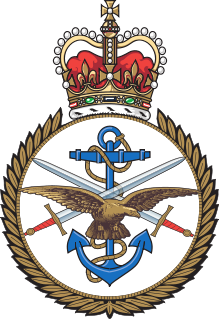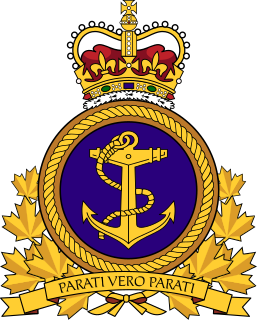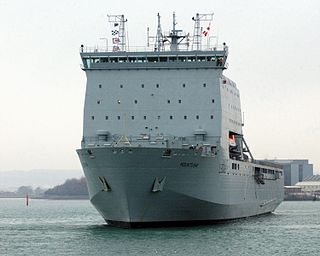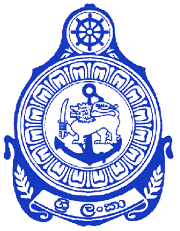Related Research Articles

The Royal Navy (RN) is the United Kingdom's naval warfare force. Although warships were used by the English kings from the early medieval period, the first major maritime engagements were fought in the Hundred Years' War against the Kingdom of France. The modern Royal Navy traces its origins to the early 16th century; the oldest of the UK's armed services, it is known as the Senior Service.

The British Armed Forces, also known as Her Majesty's Armed Forces, are the military services responsible for the defence of the United Kingdom of Great Britain and Northern Ireland, its overseas territories and the Crown dependencies. They also promote the UK's wider interests, support international peacekeeping efforts and provide humanitarian aid.

The Canadian Armed Forces, or Canadian Forces, are the unified armed forces of Canada, as constituted by the National Defence Act, which states: "The Canadian Forces are the armed forces of Her Majesty raised by Canada and consist of one Service called the Canadian Armed Forces."

The Royal Fleet Auxiliary is the fifth fighting arm of the Royal Navy. It is made up of civilian-crewed ships operated by the Ministry of Defence. It provides vital – and highly valued – logistical and operational support to the Royal Navy and Royal Marines. A committed team of personnel makes sure the Royal Navy and Royal Marines are well supplied and well supported, providing medical care, transporting kit, fuel and other essentials all over the world. In addition the RFA provides humanitarian aid, undertakes counter piracy patrols, counter narcotic operations, defence diplomacy together with assisting in preventing conflict or safeguarding the flow of international trade as single units. They are the uniformed civilian branch of the Naval Service, staffed by UK merchant sailors.

The Royal Canadian Navy is the naval force of Canada. The RCN is one of three environmental commands within the unified Canadian Armed Forces. As of 2017, The Royal Canadian Navy operates 12 frigates, 4 attack submarines, 12 coastal defence vessels and 8 patrol/training vessels, as well as several auxiliary vessels. The Royal Canadian Navy consists of 8,500 Regular Force and 5,100 Primary Reserve sailors, supported by 5,300 civilians. Vice-Admiral Art McDonald is the current Commander of the Royal Canadian Navy and Chief of the Naval Staff.

The Royal New Zealand Navy is the maritime arm of the New Zealand Defence Force. The fleet currently consists of eight ships.

HMS Somerset is a Type 23 frigate of the Royal Navy. She is the eleventh ship of the class to join the fleet since 1989. She was built by Yarrow Shipbuilders Ltd on the River Clyde, in Scotland and was launched in June 1994 by Lady Elspeth Layard, wife of then 2nd Sea Lord Admiral and Commander-in-Chief Naval Home Command Admiral Sir Michael Layard. She entered service in 1996. Lady Layard is the ship's sponsor. She is named after the Dukedom of Somerset.

HMAS Choules (L100) is a Bay-class landing ship that served with the Royal Fleet Auxiliary (RFA) from 2006 to 2011, before being purchased by the Royal Australian Navy (RAN). The vessel was built as RFA Largs Bay by Swan Hunter in Wallsend, Tyne and Wear. She was named after Largs Bay in Ayrshire, Scotland, and entered service in November 2006. During her career with the RFA, Largs Bay served as the British ship assigned to patrol the Falkland Islands in 2008, and delivered relief supplies following the 2010 Haiti earthquake.

The Bay class is a ship class of four dock landing ships built for the British Royal Fleet Auxiliary (RFA) during the 2000s. They are based on the Dutch-Spanish Royal Schelde Enforcer design and intended as a replacement for the Round Table-class logistics ships. Two ships each were ordered from Swan Hunter and BAE Systems Naval Ships. Construction work started in 2002, but saw major delays and cost overruns, particularly at Swan Hunter's shipyard. In mid-2006, Swan Hunter was stripped of work, and the incomplete second ship was towed to BAE's shipyard for completion. All four ships, Largs Bay, Lyme Bay, Mounts Bay, and Cardigan Bay had entered service by 2007.

Since the collapse of the Soviet Union in 1991 and end of the Cold War, the Royal Navy's mission transitioned from a anti-submarine focused force to a wider range of objectives around the world, while experiencing a gradual reduction in the size of its surface and submarine fleets. As a result, the Navy began a series of projects to improve its fleet, with a view to providing enhanced capabilities. This led to the replacement of smaller and more numerous units with fewer, but larger, units. For example the replacement of twelve Type 42 destroyers with six Type 45 destroyers and the replacement of the three 20,000-tonne Invincible-class aircraft carriers with two 65,000-tonne Queen Elizabeth-class aircraft carriers.

HMS Enterprise, the tenth ship to bear this name, is a multi-role survey vessel - hydrographic oceanographic (SVHO) of the Royal Navy. She has a sister ship, HMS Echo, and together they make up the Echo class of survey vessels.

Her Majesty's Naval Service, also known as the Senior Service, is the United Kingdom's naval warfare and maritime service. It consists of the Royal Navy, Royal Marines, Royal Fleet Auxiliary, Royal Naval Reserve, Royal Marines Reserve and Naval Careers Service. The term Naval Service should be distinguished from the "UK Naval Services", which consist of the Naval Service and the Merchant Navy. The Naval Service as a whole falls under the command of the Navy Board, which is headed by the First Sea Lord. This position is currently held by Admiral Tony Radakin. The Defence Council delegates administration of the Naval Service to the Admiralty Board, chaired by the Secretary of State for Defence.
15 Psychological Operations Group was a tri-service, or "purple", military unit formerly parented by 1 Military Intelligence Brigade but from April 2014, part of the Security Assistance Group within the British Army's Force Troops Command. Since April 2015, it has been subsumed into 77th Brigade within Force Troops Command.

Royal Naval Air Station Culdrose is a Royal Navy airbase near Helston on the Lizard Peninsula of Cornwall UK, and is one of the largest helicopter bases in Europe. Its main role is serving the Fleet Air Arm's front line AgustaWestland Merlin helicopter squadrons.

Joint Helicopter Command (JHC) is a tri-service organisation uniting battlefield military helicopters of the British Armed Forces for command and coordination purposes. Joint Helicopter Command reports directly to the Chief of the General Staff.

HMAS Tobruk was a Landing Ship Heavy (LSH) of the Royal Australian Navy (RAN), based on the design of the Round Table-class of the British Royal Fleet Auxiliary. Planning for the ship began in the 1970s to provide the Australian Army with a permanent sealift capability. She was laid down by Carrington Slipways in 1979, launched in 1980, and commissioned in 1981. She was a multi-purpose, roll-on/roll-off heavy lift ship capable of transporting soldiers, APCs, and tanks, and delivering them to shore via landing craft or directly by beaching.

The Sri Lanka Navy (SLN) is the naval arm of the Sri Lanka Armed Forces and is classed as the country's most vital defence force due to its island geography and is responsible for the maritime defense of the Sri Lankan nation and its interests. The role of the Sri Lanka Navy is to conduct operations at sea for the defence of the nation and its interests and conduct prompt and sustainable combat operations at sea in accordance with the national policies.
40 Commando RM is a battalion-sized formation of the British Royal Marines and subordinate unit within 3 Commando Brigade, the principal Commando formation, under the Operational Command of Commander in Chief Fleet. Their barracks are at Norton Manor Camp, Norton Fitzwarren near Taunton in Somerset.

17 Port and Maritime Regiment is a regiment of the British Army's Royal Logistic Corps. The unit is the Army's only regular Port & Maritime capability, though it is twinned with 165 Port and Maritime Regiment RLC, of the Army Reserve.
References
- 1 2 3 4 5 "Wilkinson Sword of Peace". Parliamentary Debates (Hansard) . House of Commons. 17 January 2000. col. 276W–278W.
- 1 2 3 Robinson, Peter; Christopher J. "The Wilkinson Sword of Peace". Historical RFA. Retrieved 6 January 2012.
- ↑ "Wilkinson Sword of Peace". Collections. Royal New Zealand Navy Museum. 2009. Archived from the original on 23 May 2010. Retrieved 6 June 2012.
- ↑ 2007 Defence Instruction 10-004 released in February 2007
- ↑ 2007 Defence Instruction 09-031 released in November 2007
- ↑ 2008 Defence Instruction 09-010 released in October 2008
- ↑ 2009 Defence Instruction 09-011 released in October 2009
- ↑ 2010 Defence Instruction 01-181 released in October 2010
- ↑ 2011 Defence Instruction 01-214 released in November 2011
- ↑ 2012 Defence Instruction 09-022 released in December 2012
- ↑ 2013 Defence Instruction 09-017 released in December 2013
- ↑ 2014 Defence Instruction 09-020 released in December 2014
- ↑ 2015 Defence Instruction 01-217 released in November 2015
- ↑ 2016 Defence Instruction 01-164 released in November 2016
- ↑ 2018 Defence Instruction 01-014 released in January 2018
- ↑ 2015 Defence Instruction 01-217 released in November 2015